Version en espanol abajo.
Community brigades play a key role as the first line of response to emergencies. However, there is no specific framework for their integration and strengthening at the national level. Learn how Practical Action’s Flood Resilience Program promotes these brigades as a strategy to deal with disasters in Peru.
Cyclone Yaku and heavy rains have left 61 people dead, 57 people injured and thousands of families affected and affected in Peru in the span of 5 months. The magnitude of this emergency has put all the actors of the country’s National Disaster Risk Management System (Sinagerd) to the test and has shown what limitations and advances currently exist. Undoubtedly, the key actors in responding to the emergency have been the community brigades.
Community brigades empower the neighbors who make them up by taking an active role in preparedness and response actions. They mobilise voluntarily and spontaneously in the face of an adverse situation and are the first to respond to the emergency. They know the territory, the families and the particular needs for care. They are constituted as the support of the authorities during preparedness, response and post-disaster. They are trained to provide emotional support and support in actions to care for affected people. Their work contributes to the functioning of early warning systems (EWS), effective governance and the sustainability of strategies for building resilience to landslides and floods. For this reason, community brigades are essential for disaster risk management.
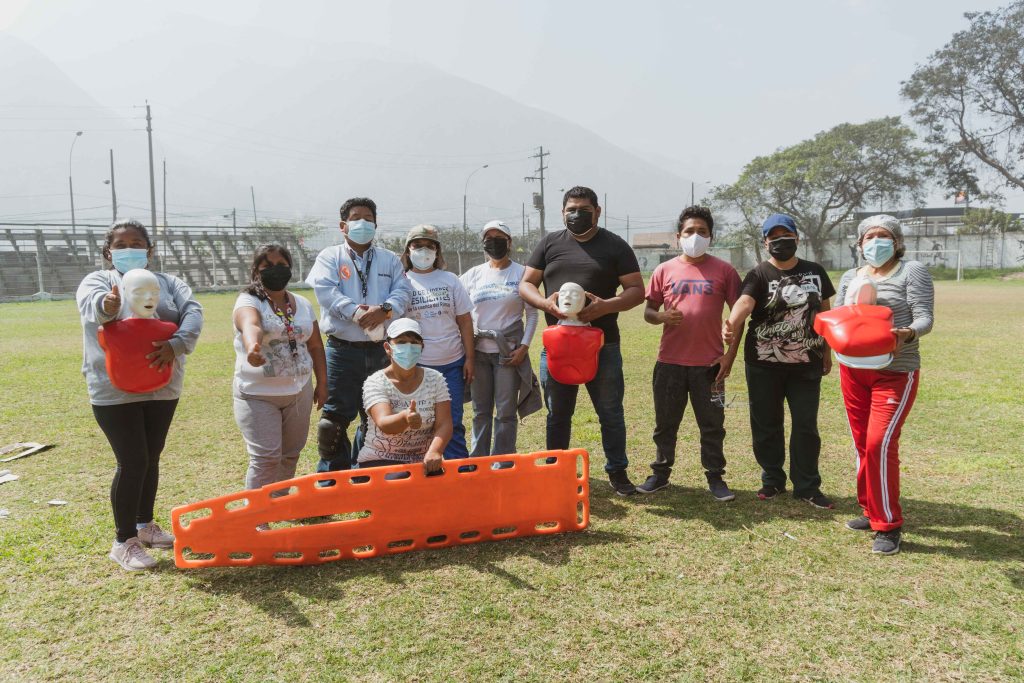
The Sendai Framework recognizes the important role of community-based organizations, including community brigades, in disaster risk reduction and emphasizes the need for collaboration among different actors for resilience building. Likewise, in Peru, the National Disaster Risk Management Plan (PLANAGERD) aims, in its objective 6, to strengthen the participation of the population and organized society for the development of a culture of prevention. Despite this, there is no specific framework for the integration and strengthening of community disaster risk management brigades and they often do not receive the necessary recognition and support.
Promoting community brigades
Historically, in the Rimac basin, the scene of frequent landslides and floods, disasters have occurred whose frequency and intensity are increasing due to factors such as climate change and the lack of urban planning. In this context, Practical Action’s Flood Resilience Program in Peru has been promoting the formation of community brigades since 2013 as a strategy to deal with emergency situations.
The Practical Action team designed a training program for community brigade members aimed at volunteers who come, mainly, from human settlements that have experienced emergency situations due to natural phenomena.
The program is carried out in direct collaboration with local authorities at the municipal and provincial levels, the National Institute of Civil Defense (INDECI), other NGOs, health institutions, fire companies and other key actors in the community using as a basis the INDECI guidelines and the guide for the development of the community emergency plan.
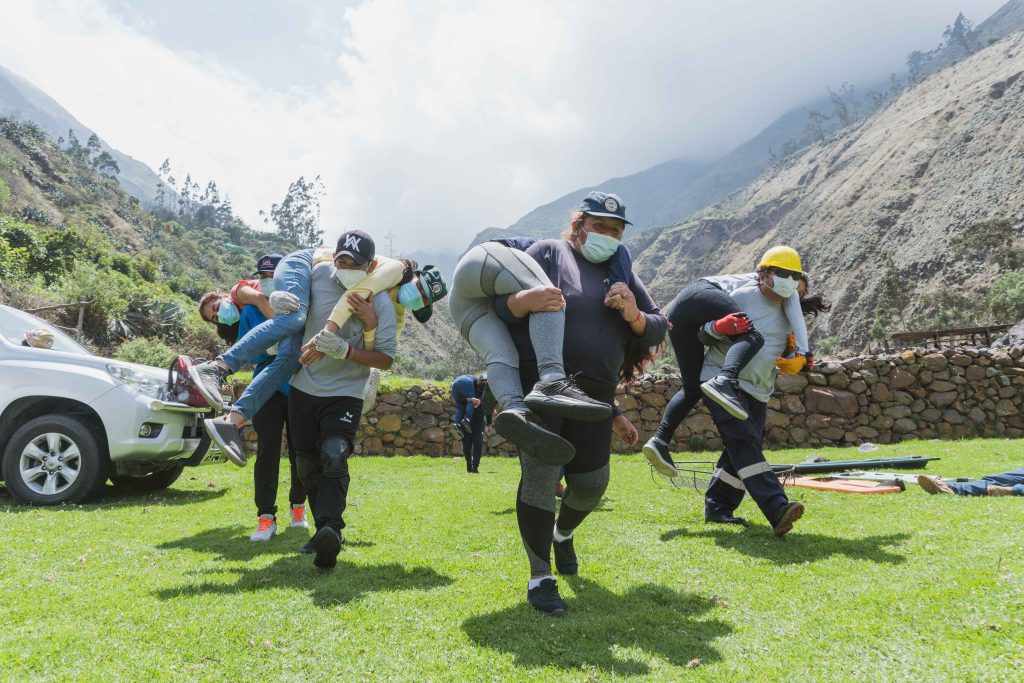
The trainings are given through face-to-face and virtual sessions with a team of facilitators, experts and leaders for each topic. The training begins with guided tours of the impact areas of the landslides to recognize vulnerable points, safe areas, estimate evacuation times and better understand the behavior of the hazards and the risk condition in each community. The curriculum addresses topics such as disaster preparedness, community brigade organization, post-disaster emotional management, basic first aid, and search and rescue
During the training process, community risk maps and emergency plans are prepared in a participatory manner, the roles and operation of the brigades are identified, and information is provided on the disaster risk management policy and the law and regulations of Sinagerd. Likewise, the practical sessions allow you to exercise in the management of first aid, security, evacuation, rescue and fire prevention.
This brigade training program seeks participation and interaction between the organizing team and the volunteers among themselves to create a space of trust and familiarity for people who share the same problem and concern for the basin.
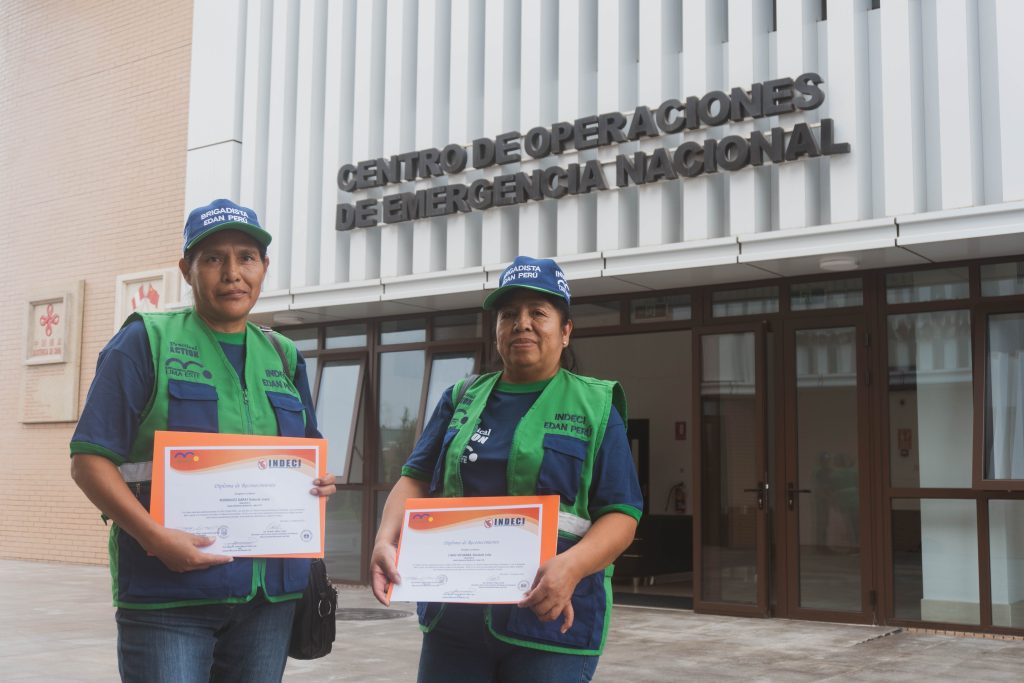
The calls are open to the entire community, however, women and the elderly have been the most receptive sector of the population to get involved. Currently, the participants have had a multiplier effect and they are the ones who are in charge of extending the invitation and expanding the network of brigadistas in the Rimac basin.
Since the beginning of the project, Practical Action has reached an average of 8,000 participants and has contributed to the formation of 31 community brigades in the areas most affected by landslides and floods.
A recognized effort
This work over the years has made it possible to consolidate a fundamental human and social capital for community resilience in the Rimac basin. However, greater institutional support is still needed to ensure the sustainability of this type of intervention.
Just as important as legitimacy is the formalization of the brigadistas. For this reason, one of the key strategies has been the alliance with local governments who validate the training process of the brigades through accreditation. In the Rimac basin, Practical Action has achieved the accreditation of brigade members by the municipalities of Ate, Chaclacayo, Lurigancho, Santa Eulalia and Matucana.
During the emergency caused by El Niño Costero, in 2017, and by Cyclone Yaku, in 2023, the brigade members attended to the needs of people in their communities and collaborated with first response institutions such as local governments, the Armed Forces, firefighters, and INDECI.
“We persuaded people to be able to leave their homes. Many did not want to leave, but with great wisdom and with the training we have been able to help people evacuate from their homes in time and thus save lives. Because that is our job as brigadistas.” – Angélica Chate, Community Brigade Member
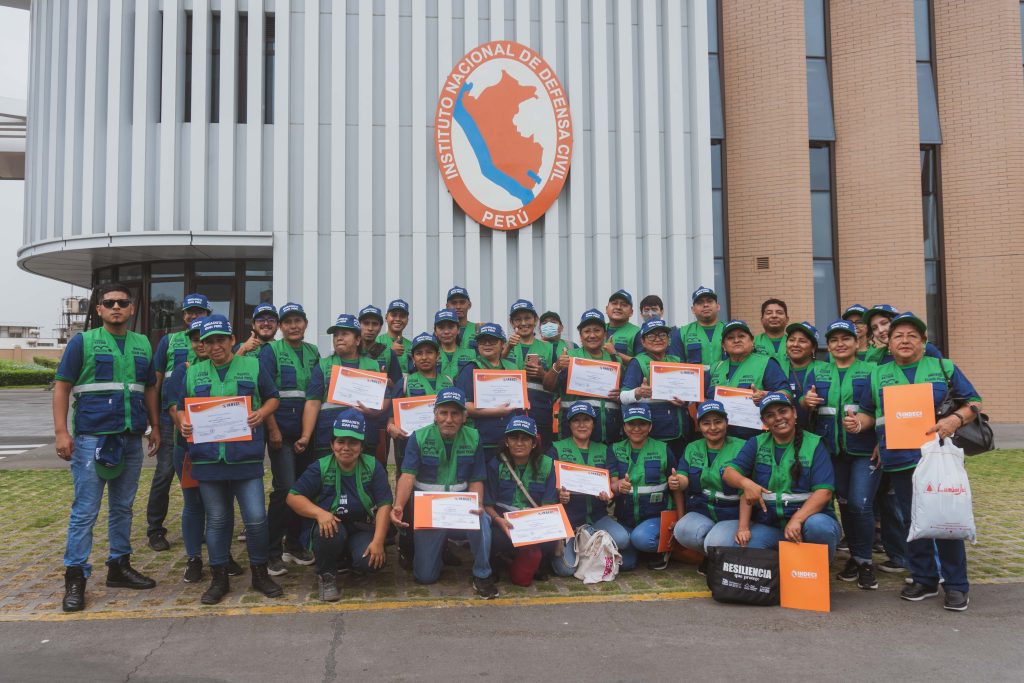
In addition, INDECI and the Mancomunidad de Lima Este promoted a series of training sessions in Damage Assessment and Needs Analysis (EDAN) to the brigades previously formed by Practical Action. Organizing a team of EDAN brigade members with 40 members who went to the areas affected by the rains to collect fundamental data on the impact on health and livelihoods, as well as the most urgent needs. This information fueled response actions, as well as the mobilization and delivery of humanitarian aid resources.
In April 2023, INDECI recognized the EDAN brigade members at the facilities of the National Emergency Operations Center. This recognition is a step forward towards a necessary institutionalization of the community brigades and their role within Sinagerd.
It is important to remember that the volunteers of these brigades are members of the same communities they help and, during the emergency caused by Cyclone Yaku, many of them and their families were directly impacted. Despite this, the brigade members continued their work and constant training, demonstrating the commitment they have towards building resilience in their communities.
Example in Mexico
Similarly, the Mexican Red Cross led an experience with community brigade members and their institutional recognition after the flood emergencies in 2020. In October and November 2020, hurricanes Eta and Iota caused intense rains in Tabasco, causing the most severe flooding in the decade. However, the population was prepared.
The community brigades formed since 2013 by the Mexican Red Cross were put to the test and proved to be effective in dealing with the emergency. For this, the recognition of the brigades by the local authorities, in particular Civil Protection, was fundamental. It allowed for communication between stakeholders on forecasts and up-to-date information so that brigades can plan response activities, even before the flood hit.
Likewise, the community brigades were able to identify the most critical needs to better target access to support during the emergency. In some communities, they carried out a Damage Assessment and Needs Analysis (EDAN) that served to request specific support from government institutions. As members of the Zurich Flood Resilience Alliance, the Practical Action teams and the Mexican Red Cross were able to share learnings and experiences in relation to community brigades.
The future of community brigades
The examples of Mexico and Peru show the importance of community brigades as fundamental actors for disaster risk management. However, it is still a challenge to formally integrate them into national disaster risk management systems.
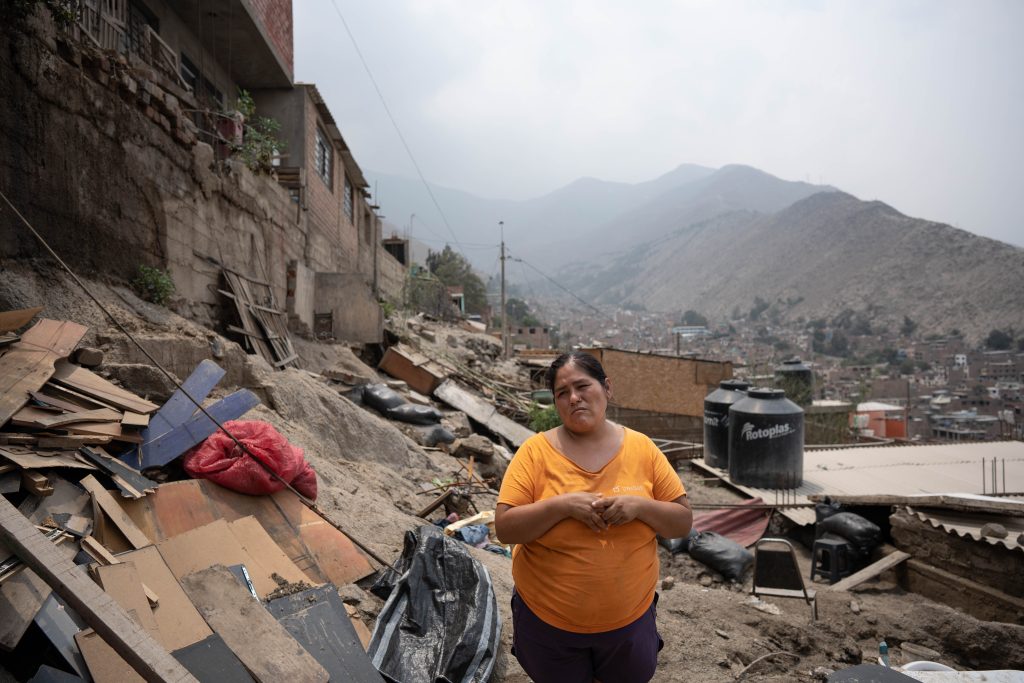
An important advance has been the implementation of Volunteering in Emergencies and Rehabilitation (VER), which is a mechanism by which members of organized civil society can join Sinagerd and carry out key actions in the Preparedness, Response and Rehabilitation processes. According to the guidelines of the VER, it is the responsibility of the three levels of government to allocate financial and logistical resources for the operation of volunteering. But in reality we find a series of important limitations when executing this.
The members of the community brigades often live in conditions of vulnerability and are directly impacted by emergency situations. Without adequate institutional support to ensure the constant training, growth and strengthening of the brigades and their sustainability over time, it is likely that many brigades will suffer general wear and tear that prevents them from carrying out their work or that will ultimately cause the brigades to be disbanded, thus losing fundamental human and social capital for community resilience.
Local governments are called upon to give sustainability and legality to community brigades, integrating them into civil defense platforms and assuming their permanent training.
Brigadas comunitarias hacia adelante
Las brigadas comunitarias juegan un rol clave como primera línea de respuesta ante las emergencias. Sin embargo, no existe un marco específico para su integración y fortalecimiento a nivel nacional. Conoce cómo el Programa de Resiliencia ante Inundaciones de Practical Action promueve estas brigadas como estrategia para hacerle frente a los desastres en Perú.
El ciclón Yaku y las lluvias intensas han dejado 61 personas fallecidas, 57 personas heridas y miles de familias damnificadas y afectadas en Perú en el lapso de 5 meses. La magnitud de esta emergencia a puesto a prueba a todos los actores del Sistema Nacional de Gestión del Riesgo de Desastres (Sinagerd) del país y ha mostrado qué limitaciones y avances existen actualmente. Sin duda, los actores clave al momento de responder a la emergencia han sido las brigadas comunitarias.
Las brigadas comunitarias empoderan a las y los vecinos que las conforman al tomar un rol activo en las acciones de preparación y respuesta. Se movilizan de forma voluntaria y espontánea ante una situación adversa y son las primeras en responder a la emergencia. Conocen el territorio, a las familias y las necesidades particulares de atención. Se constituyen como el soporte de las autoridades durante la preparación, respuesta y post desastre. Están capacitadas para dar soporte emocional y apoyar en las acciones de atención a las personas afectadas. Su trabajo contribuye al funcionamiento de los sistemas de alerta temprana (SAT), a la gobernanza efectiva y a la sostenibilidad de las estrategias para la construcción de resiliencia ante huaicos e inundaciones. Por ello, las brigadas comunitarias son fundamentales para la gestión del riesgo de desastres.

El Marco de Sendai reconoce el importante papel de las organizaciones comunitarias, incluidas las brigadas comunitarias, en la reducción del riesgo de desastres y hace énfasis en la necesidad de colaboración entre los distintos actores para la construcción de resiliencia. Asimismo, en Perú, el Plan Nacional de Gestión del Riesgo de Desastres (PLANAGERD) apunta, en su objetivo 6, a fortalecer la participación de la población y la sociedad organizada para el desarrollo de una cultura de prevención. A pesar de esto, no existe un marco específico para la integración y fortalecimiento de las brigadas comunitarias de gestión de riesgo de desastres y muchas veces estas no reciben el reconocimiento y apoyo necesario.
Impulsar brigadas comunitarias
Históricamente, en la cuenca del Rímac, escenario de frecuentes huaicos e inundaciones, han ocurrido desastres cuya frecuencia e intensidad está en aumento por factores como el cambio climático y la falta de planificación urbana. En este contexto, el Programa de Resiliencia ante Inundaciones de Practical Action en Perú impulsa desde 2013 la formación de brigadas comunitarias como estrategia para hacerle frente a situaciones de emergencia.
El equipo de Practical Action diseñó un programa de capacitación para brigadistas comunitarios dirigido a voluntarias y voluntarios que provienen, principalmente, de asentamientos humanos que han experimentado situaciones de emergencias por fenómenos naturales.
El programa se realiza en colaboración directa con las autoridades locales a nivel municipal y provincial, el Instituto Nacional de Defensa Civil (INDECI), otras ONG, instituciones de salud, las compañías de bomberos y otros actores clave en la comunidad usando como base los lineamientos del INDECI y la guía de elaboración del plan comunitario de emergencia.

Las capacitaciones se dan a través de sesiones presenciales y virtuales con un equipo de facilitadores, expertos y líderes para cada tema. La formación inicia con visitas guiadas por las zonas de impacto de los huaicos para reconocer los puntos vulnerables, las zonas seguras, estimar los tiempos para evacuar y entender mejor el comportamiento de los peligros y la condición de riesgo en cada comunidad. El plan curricular aborda temas como preparación ante desastres, organización de brigadas comunitarias, manejo emocional post-desastres, primeros auxilios básicos y búsqueda y rescate
Durante el proceso de capacitación se elaboran participativamente mapas comunitarios de riesgo y planes de emergencia, se identifican los roles y el funcionamiento de las brigadas y se brinda información sobre la política de gestión del riesgo de desastre y la ley y el reglamento del Sinagerd. Asimismo, las sesiones prácticas permiten ejercitarse en el manejo de primeros auxilios, seguridad, evacuación, rescate y prevención de incendios.
Este programa de formación de brigadas busca la participación e interacción entre el equipo organizador y las y los voluntarios entre sí para crear un espacio de confianza y familiaridad para personas que comparten una misma problemática y preocupación por la cuenca.

Las convocatorias son abiertas a toda la comunidad, sin embargo, las mujeres y los adultos mayores han sido el sector más receptivo de la población al involucrarse. Actualmente, las y los participantes han tenido un efecto multiplicador y son ellos mismos quienes se encargan de extender la invitación y ampliar la red de brigadistas en la cuenca del Rímac.
Desde el inicio del proyecto, Practical Action ha alcanzado a un promedio de 8 mil participantes y ha contribuido a formar 31 brigadas comunitarias en las zonas más afectadas por huaicos e inundaciones.
Un esfuerzo reconocido
Este trabajo a través de los años ha permitido consolidar un capital humano y social fundamental para la resiliencia comunitaria en la cuenca del Rímac. Sin embargo, sigue siendo necesario un mayor respaldo institucional para asegurar la sostenibilidad de este tipo de intervenciones.
Tan importante como la legitimidad es la formalización de los brigadistas. Por ello, una de las estrategias clave ha sido la alianza con los gobiernos locales quienes validan el proceso formativo de las brigadas a través de la acreditación. En la cuenca del Rímac, Practical Action ha logrado la acreditación de brigadistas por las municipalidades de Ate, Chaclacayo, Lurigancho, Santa Eulalia y Matucana.
Durante la emergencia por El Niño Costero, en 2017, y por el ciclón Yaku, en 2023, las y los brigadistas atendieron las necesidades de las personas en sus comunidades y colaboraron con instituciones de primera respuesta con los gobiernos locales, las Fuerzas Armadas, los bomberos y el INDECI.
“Persuadíamos a las personas a que puedan salir de sus casas. Muchos no querían salir, pero nosotros con mucho tino y con las capacitaciones hemos podido ayudar a las personas a evacuar de su casa a tiempo y así salvar vidas. Porque ese es nuestro trabajo como brigadistas”. – Angélica Chate, Brigadista comunitaria

De manera complementaria, INDECI y la Mancomunidad de Lima Este promovieron una serie de jornadas de capacitación en Evaluación de Daños y Análisis de Necesidades (EDAN) a las brigadas previamente conformadas por Practical Action. Organizando un equipo de brigadistas EDAN con 40 integrantes quienes se constituyeron a las zonas afectadas por las lluvias para recoger datos fundamentales sobre la afectación a la salud y a los medios de vida, así como las necesidades más urgentes. Esta información alimentó la toma de acciones de respuesta, así como la movilización y entrega de recursos de ayuda humanitaria.
En abril 2023 INDECI reconoció a los brigadistas EDAN en las instalaciones del Centro de Operaciones de Emergencia Nacional. Este reconocimiento es un paso a adelante hacia una necesaria institucionalización de las brigadas comunitarias y su rol dentro del Sinagerd.
Es importante recordar que las personas voluntarias de estas brigadas son miembros de las mismas comunidades que auxilian y, durante la emergencia por el ciclón Yaku, muchas de ellas y sus familiares fueron directamente impactadas. A pesar de esto, las y los brigadistas continuaron su labor y constante capacitación evidenciando el compromiso que tienen hacia la construcción de resiliencia en sus comunidades.
Ejemplo en México
De manera similar, la Cruz Roja Mexicana lideró una experiencia con brigadistas comunitarios y su reconocimiento institucional tras las emergencias por inundaciones en 2020. En octubre y noviembre de 2020, los huracanes Eta e Iota provocaron intensas lluvias en Tabasco ocasionando las inundaciones más severas de la década. Sin embargo, la población estaba preparada.
Las brigadas comunitarias formadas desde el 2013 por la Cruz Roja Mexicana fueron puestas a prueba y demostraron ser efectivas para hacerle frente a la emergencia. Para esto, el reconocimiento de las brigadas por parte de las autoridades locales, en particular de Protección Civil, fue fundamental. Ya que permitió mantener una comunicación entre las partes interesadas sobre pronósticos e información actualizada para que las brigadas puedan planificar las actividades de respuesta, incluso antes de que llegara la inundación.
Asimismo, las brigadas comunitarias fueron capaces de identificar las necesidades más críticas para orientar mejor el acceso a apoyo durante la emergencia. En algunas comunidades realizaron una Evaluación de Daños y Análisis de Necesidades (EDAN) que sirvió para solicitar apoyo específico a las instituciones gubernamentales. Como miembros de la Alianza para la resiliencia ante inundaciones de Zurich, los equipo de Practical Action y la Cruz Roja Mexicana pudieron compartir aprendizajes y experiencias en relación con las brigadas comunitarias.
El futuro de las brigadas comunitarias
Los ejemplos de México y Perú evidencian la importancia de las brigadas comunitarias como actores fundamentales para la gestión de riesgo de desastres. Sin embargo, aún es un reto lograr integrarlas formalmente en los sistemas nacionales de gestión de riesgo de desastres.

Un avance importante ha sido la implementación del Voluntariado en Emergencias y Rehabilitación (VER) que es un mecanismo por el cual miembros de la sociedad civil organizada pueden integrarse al Sinagerd y realizar acciones clave en los procesos de Preparación, Respuesta y Rehabilitación. Según los lineamientos del VER, es responsabilidad de los tres niveles de gobierno destinar recursos financieros y logísticos para el funcionamiento del voluntariado. Pero en la realidad encontramos una serie de limitaciones importantes al momento de ejecutar esto.
Las y los miembros de las brigadas comunitarias muchas veces viven en condiciones de vulnerabilidad y son directamente impactados por las situaciones de emergencia. Sin un adecuado respaldo institucional que asegure la constante capacitación, el crecimiento y fortalecimiento de las brigadas y su sostenibilidad en el tiempo, es probable que muchas brigadas sufran un desgaste general que impida que realicen su labor o que finalmente ocasione que las brigadas sean disueltas, perdiendo así un capital humano y social fundamental para la resiliencia comunitaria.
Los gobiernos locales son los llamados a darle sostenibilidad y legalidad a las brigadas comunitarias, integrándolas a las plataformas de defensa civil y asumiendo su formación permanente.

Comments